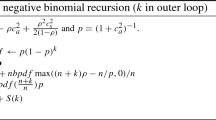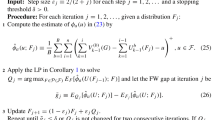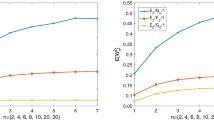Abstract
We examine a family ofGI/GI/1 queueing processes generated by a parametric family of service time distributions,F(x,θ), and we show that under suitable conditions the corresponding customer stationary expectation of the system time is twice continuously differentiable with respect toθ. Expressions for the derivatives are given which are suitable for single run derivative estimation. These results are extended to parameters of the interarrival time distribution and expressions for the corresponding second derivatives (as well as partial second derivatives involving both interarrivai and service time parameters) are also obtained. Finally, we present perturbation analysis algorithms based on these expressions along with simulation results demonstrating their performance.
Similar content being viewed by others
References
S. Asmussen,Applied Probability and Queues (Wiley, 1987).
F. Baccelli and P. Brémaud,Palm Probabilities, Lecture Notes in Statistics (Springer, 1986).
P. Brémaud and Lasgouttes, Stationary IPA estimates for non-smooth functions of theGI/GI/1/∞ workload, Rapp. de Rech. INRIA No. 1677 (1992).
P. Konstantopoulos and M. Zazanis, Sensitivity analysis for stationary and ergodic queues, J. Appl. Prob. 24 (1992) 738–750.
P. Konstantopoulos and M. Zazanis, A note on the sensitivity analysis for stationary and ergodic queues, Adv. Appl. Prob. (1993), to appear.
H. Chernoff, A measure of asymptotic efficiency for tests of a hypothesis based on the sum of observations, Ann. Math. Stat. 23 (1952) 493–507.
P. Glasserman,Gradient Estimation via Perturbation Analysis (Kluwer Academic, 1990).
P. Glasserman, Structural conditions for perturbation analysis derivative estimation: Finite time performance indices, Oper. Res. 39 (1992) 724–738.
P. Glasserman, J.Q. Hu and S.G. Strickland, Strongly consistent steady state derivative estimates, Prob. Inf. Eng. Sci. 5 (1991) 391–414.
P.W. Glynn, Likelihood ratio gradient estimation: An overview,Proc. 1987 Winter Simulation Conf. (1987) pp. 366–375.
A. Gut,Stopped Random Walks (Springer, 1988).
P. Heidelberger, X.R. Cao, M.A. Zazanis and R. Suri, Convergence properties of infinitesimal perturbation analysis, Manag. Sci. 34 (1988) 1281–1302.
Y.C. Ho and X.R. Cao, Perturbation analysis and optimization of queueing networks, J. Optim. Theory Appl. 40 (1983) 559–582.
Y.C. Ho and X.R. Cao,Perturbation Analysis of Discrete Event Dynamic Systems (Kluwer Academic, 1991).
J.Q. Hu, Convexity of sample path performance and strong consistency of infinitesimal perturbation analysis estimates, IEEE Trans. Auto. Contr. AC-37 (1992) 258–262.
J.F.C. Kingman, Some inequalities for the queueGI/G/1, Biometrika 49 (1962) 315–324.
L. Kleinrock,Queueing Systems I (Wiley, 1975).
P. L'Ecuyer, P.N. Giroux and P.W. Glynn, Stochastic optimization by simulation: Some experiments with a simple steady state queue, Working Paper, Université Laval (1989).
M.S. Meketon and P. Heidelberger, A renewal theoretic approach to bias reduction in regenerative simulations, Manag. Sci. 28 (1982) 173–181.
M.I. Reiman and A. Weiss, Sensitivity analysis of simulations via likelihood ratios, Oper. Res. 37 (1989) 830–844.
M.I. Reiman and B. Simon, Open queueing systems in light traffic, Math. Oper. Res. 14 (1989) 26–59.
A.C.M. van Rooij and W.H. Schikhof,A Second Course on Real Functions (Cambridge University Press, 1982).
R.Y. Rubinstein, Sensitivity analysis and performance extrapolation for computer simulation models, Oper. Res. 37 (1989) 72–81.
A.N. Shiryayev,Probability (Springer, 1984).
W.F. Stout,Almost Sure Convergence (Academic Press, 1974).
R. Suri, Infinitesimal perturbation analysis for general discrete event systems, J. ACM 34 (1987) 686–717.
R. Suri, Perturbation analysis: The state of the art and research issues explained via theGI/G/1 queue, Proc. IEEE 77 (1989) 114–137.
R. Suri and Y.T. Leung, Single run optimization of discrete event systems: Experimental investigation for theM/M/1 queue, IIE Trans. 21 (1989) 35–49.
R. Suri and M.A. Zazanis, Perturbation analysis gives strongly consistent sensitivity estimates for theM/G/1 queue, Manag. Sci. 34 (1988) 39–64.
R.W. Wolff,Stochastic Modeling and the Theory of Queues (Prentice-Hall, 1989).
M.A. Zazanis and R. Suri, Convergence rates of finite-difference sensitivity estimates for stochastic systems, Oper. Res. 41 (1993) 694–703.
M.A. Zazanis, Weak convergence of sample path derivatives forGI/G/1 queues,Proc. 25th Allerton Conf. on Communication, Control, and Computing (1989) pp. 297–304.
Author information
Authors and Affiliations
Rights and permissions
About this article
Cite this article
Zazanis, M.A., Suri, R. Perturbation analysis of theGI/GI/1 queue. Queueing Syst 18, 199–248 (1994). https://doi.org/10.1007/BF01158763
Received:
Revised:
Issue Date:
DOI: https://doi.org/10.1007/BF01158763




